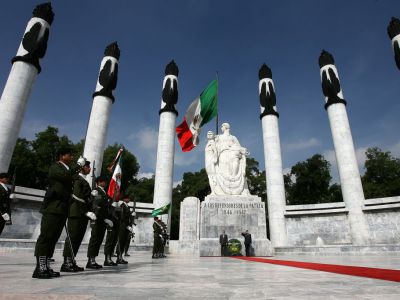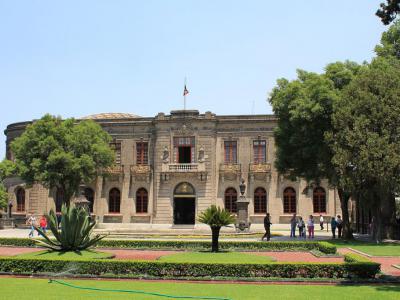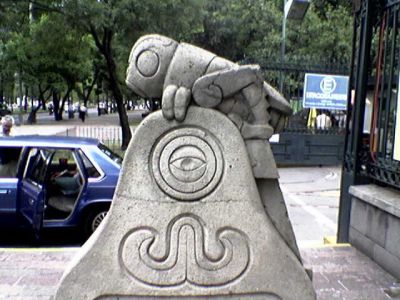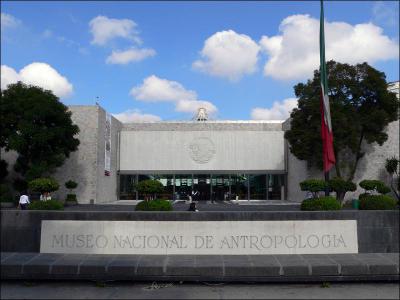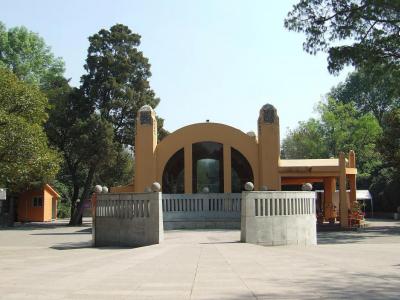
Chapultepec Park Walking Tour (Self Guided), Mexico City
Nicknamed "the Lungs of Mexico City", Chapultepec Park is a vast oasis of lush greenery in the heart of the Mexican capital, sprawling over 686 hectares of land, providing a vital source of oxygen for the city. Rich in natural beauty, historical landmarks, and vibrant atmosphere, throughout centuries, this park has inspired various works of literature, poetry, and visual art, further solidifying its place as a symbol of Mexican identity.
Historically, the significance of the Chapultepec area dates back to the pre-Columbian era when it served as a retreat for Aztec rulers. The Aztec emperor Moctezuma II had a summer residence here, on the hill now occupied by the Chapultepec Castle. And later, during the colonial period, Chapultepec Park accommodated Spanish viceroys. Its name comes from the Nahuatl language and means "Hill of the Grasshopper."
Today, the park is divided into three sections. Within the first section, you can find several museums such as the Museum of Modern Art and the National Museum of Anthropology, showcasing a vast array of Mexican and international artistic and historic heritage. The second section is dedicated to recreational activities, while the third, known as the Chapultepec Forest ("Bosque de Chapultepec"), is a tranquil nature reserve, home to diverse flora and fauna, providing opportunities for the lovers of various outdoor activities such as hiking, birdwatching, and more.
Among other prominent features of the park is the Ninos Heroes Monument, otherwise known as the Monument to the Heroic Cadets, commemorating brave military cadets who valiantly fought against the invading U.S. forces during the Battle of Chapultepec in 1847, during the Mexican-American War. Also, Chapultepec Zoo – one of the oldest and most important zoological institutions in Latin America – has been a popular attraction within the park since 1923.
If you seek a peaceful and multifaceted retreat from the bustling city that combines history, culture, and natural beauty, Chapultepec Park is just what you need.
Historically, the significance of the Chapultepec area dates back to the pre-Columbian era when it served as a retreat for Aztec rulers. The Aztec emperor Moctezuma II had a summer residence here, on the hill now occupied by the Chapultepec Castle. And later, during the colonial period, Chapultepec Park accommodated Spanish viceroys. Its name comes from the Nahuatl language and means "Hill of the Grasshopper."
Today, the park is divided into three sections. Within the first section, you can find several museums such as the Museum of Modern Art and the National Museum of Anthropology, showcasing a vast array of Mexican and international artistic and historic heritage. The second section is dedicated to recreational activities, while the third, known as the Chapultepec Forest ("Bosque de Chapultepec"), is a tranquil nature reserve, home to diverse flora and fauna, providing opportunities for the lovers of various outdoor activities such as hiking, birdwatching, and more.
Among other prominent features of the park is the Ninos Heroes Monument, otherwise known as the Monument to the Heroic Cadets, commemorating brave military cadets who valiantly fought against the invading U.S. forces during the Battle of Chapultepec in 1847, during the Mexican-American War. Also, Chapultepec Zoo – one of the oldest and most important zoological institutions in Latin America – has been a popular attraction within the park since 1923.
If you seek a peaceful and multifaceted retreat from the bustling city that combines history, culture, and natural beauty, Chapultepec Park is just what you need.
How it works: Download the app "GPSmyCity: Walks in 1K+ Cities" from Apple App Store or Google Play Store to your mobile phone or tablet. The app turns your mobile device into a personal tour guide and its built-in GPS navigation functions guide you from one tour stop to next. The app works offline, so no data plan is needed when traveling abroad.
Chapultepec Park Walking Tour Map
Guide Name: Chapultepec Park Walking Tour
Guide Location: Mexico » Mexico City (See other walking tours in Mexico City)
Guide Type: Self-guided Walking Tour (Sightseeing)
# of Attractions: 5
Tour Duration: 2 Hour(s)
Travel Distance: 3.8 Km or 2.4 Miles
Author: doris
Sight(s) Featured in This Guide:
Guide Location: Mexico » Mexico City (See other walking tours in Mexico City)
Guide Type: Self-guided Walking Tour (Sightseeing)
# of Attractions: 5
Tour Duration: 2 Hour(s)
Travel Distance: 3.8 Km or 2.4 Miles
Author: doris
Sight(s) Featured in This Guide:
- Ninos Heroes Monument
- Chapultepec Castle
- Museum of Modern Art
- National Museum of Anthropology
- Chapultepec Zoo
1) Ninos Heroes Monument
Standing proudly at the entrance of Chapultepec Park is a grand monument that pays tribute to six courageous Mexican teenage military cadets. These valiant young souls lost their lives defending Mexico when the Chapultepec castle in Mexico City came under siege by the US army.
Fashioned from elegant Carrara marble, the Niños Héroes Memorial was a creation envisioned by architect Enriquez Aragon and skillfully brought to life by sculptor Ernesto Tamariz in 1952. This structure serves as a poignant reminder of the young heroes it honors, all of whom were military cadets between the tender ages of 13 and 19.
Among these gallant cadets was Juan Escutia, who, in an act of unwavering patriotism, wrapped himself in the Mexican flag and made a daring leap to his death, ensuring it would never fall into enemy hands. The profound sacrifice of these noble young souls earned them a resting place within the grounds of Chapultepec Park. And in 1952, their remains were laid to rest within the monument, ensuring that the memory of their unwavering courage would endure through the ages.
As you approach the monument, you'll be greeted by a striking sculpture portraying a mother cradling her dying son in her arms, symbolizing the profound loss and sacrifice of these young cadets. Six pillars encircle the sculpture in a graceful semicircle, each representing one of the six brave souls. Crowned with bronze torches, these pillars stand tall, illuminating the everlasting bravery that resides within the hearts of these courageous young men.
Fashioned from elegant Carrara marble, the Niños Héroes Memorial was a creation envisioned by architect Enriquez Aragon and skillfully brought to life by sculptor Ernesto Tamariz in 1952. This structure serves as a poignant reminder of the young heroes it honors, all of whom were military cadets between the tender ages of 13 and 19.
Among these gallant cadets was Juan Escutia, who, in an act of unwavering patriotism, wrapped himself in the Mexican flag and made a daring leap to his death, ensuring it would never fall into enemy hands. The profound sacrifice of these noble young souls earned them a resting place within the grounds of Chapultepec Park. And in 1952, their remains were laid to rest within the monument, ensuring that the memory of their unwavering courage would endure through the ages.
As you approach the monument, you'll be greeted by a striking sculpture portraying a mother cradling her dying son in her arms, symbolizing the profound loss and sacrifice of these young cadets. Six pillars encircle the sculpture in a graceful semicircle, each representing one of the six brave souls. Crowned with bronze torches, these pillars stand tall, illuminating the everlasting bravery that resides within the hearts of these courageous young men.
2) Chapultepec Castle (must see)
Perched high above Mexico City, Chapultepec Castle offers breathtaking views and holds a unique distinction as the sole seat of a sovereign in North America. The castle stands proudly atop Chapultepec Hill and currently serves as the distinguished home of the National Museum of History.
Originally constructed in 1725 for the Spanish viceroy, Bernardo de Galvez, the castle came under the ownership of Mexico City in 1806. Its history took intriguing turns as, in 1833, it transformed into a military academy with the addition of the Caballero Alto (Tall Knight) tower to its grand structure. A poignant event in 1847 saw the castle defended by brave young heroes aged between 14 and 20, who valiantly fought against US troops during a siege. Their sacrifice was forever commemorated with a captivating mural adorning the entrance ceiling.
In 1864, the castle saw an extraordinary transformation when Emperor Maximilian I and Empress Carlota of Mexico made it their regal residence. A series of extensive architectural and landscape changes rendered it a palace befitting royalty. Subsequently, in 1882, Porfirio Diaz designated the castle as the official residence of the Mexican President.
However, in 1939, the castle relinquished its role as the President's residence and opened its doors to the public as the National Museum of History. The museum thoughtfully presents exhibits in chronological order, allowing visitors to journey through time from the Aztec Empire to the intriguing era of the 1930s.
Why You Should Visit:
The only Imperial castle in America! Very cheaply priced and with a beautiful view of the Reforma Avenue which was originally modeled after the Champs-Élysées in Paris to remind Maximilian's wife, Carlota, of her home. The surrounding area of Chapultepec Park boasts a Zoo and many other attractions to complete the day.
Tip:
Try to see when the ballet folklórico is performing because to see their show after the museum closes is a great experience!
At the top, you can go to the right to see the Caracol History Museum (made in the shape of a shell) which has some informative dioramas explaining the very complex history of Mexico.
Originally constructed in 1725 for the Spanish viceroy, Bernardo de Galvez, the castle came under the ownership of Mexico City in 1806. Its history took intriguing turns as, in 1833, it transformed into a military academy with the addition of the Caballero Alto (Tall Knight) tower to its grand structure. A poignant event in 1847 saw the castle defended by brave young heroes aged between 14 and 20, who valiantly fought against US troops during a siege. Their sacrifice was forever commemorated with a captivating mural adorning the entrance ceiling.
In 1864, the castle saw an extraordinary transformation when Emperor Maximilian I and Empress Carlota of Mexico made it their regal residence. A series of extensive architectural and landscape changes rendered it a palace befitting royalty. Subsequently, in 1882, Porfirio Diaz designated the castle as the official residence of the Mexican President.
However, in 1939, the castle relinquished its role as the President's residence and opened its doors to the public as the National Museum of History. The museum thoughtfully presents exhibits in chronological order, allowing visitors to journey through time from the Aztec Empire to the intriguing era of the 1930s.
Why You Should Visit:
The only Imperial castle in America! Very cheaply priced and with a beautiful view of the Reforma Avenue which was originally modeled after the Champs-Élysées in Paris to remind Maximilian's wife, Carlota, of her home. The surrounding area of Chapultepec Park boasts a Zoo and many other attractions to complete the day.
Tip:
Try to see when the ballet folklórico is performing because to see their show after the museum closes is a great experience!
At the top, you can go to the right to see the Caracol History Museum (made in the shape of a shell) which has some informative dioramas explaining the very complex history of Mexico.
3) Museum of Modern Art
Situated on the eastern side of Chapultepec Park, adjacent to the Paseo de la Reforma, lies a repository showcasing an impressive collection of paintings, lithography, photography, and sculptures crafted by talented Mexican artists from the 19th and 20th centuries.
Designed by the acclaimed Mexican architects Rafael Mijares and Pedro Ramirez Vazquez, the Museum of Modern Art (Museo de Arte Moderno) boasts an elegant round structure with two floors interconnected by a central stairway. Within its walls, six galleries proudly display a diverse array of artistic masterpieces beneath sky-lit rotundas.
The museum's permanent collection is a treasure trove of paintings by illustrious 20th-century Mexican artists, including Frida Kahlo, Olga Costa, Gelsen Gas, Diego Rivera, Rufino Tamayo, Vladimir Kora, and other remarkable talents. Additionally, the surrounding gardens play host to numerous free-standing works created by prominent modern Mexican sculptors. The museum pays tribute to the legacies of three great muralists, Diego Rivera, Jose Clemente Orozco, and Manuel Alvarez Bravo, with captivating exhibits of their renowned creations.
As an integral part of its offerings, the institution proudly presents exceptional temporary Mexican and international modern art collections. Among its most celebrated pieces are "Las dos Fridas" by Frida Kahlo and "La Vendedoras de Frutas" by Olga Costa, both of which have earned global recognition.
The museum warmly welcomes visitors and offers guided tours to enrich their experience of the exhibits. For those seeking further insight, an extensive collection of informative reference books is available at the library.
Why You Should Visit:
A great opportunity to explore the endless creativity of modern Mexican artists.
The infrastructure includes baggage storage, nice and pleasant coffee-shop, good bookshop, lavatories, lift, and access for disabled persons.
Designed by the acclaimed Mexican architects Rafael Mijares and Pedro Ramirez Vazquez, the Museum of Modern Art (Museo de Arte Moderno) boasts an elegant round structure with two floors interconnected by a central stairway. Within its walls, six galleries proudly display a diverse array of artistic masterpieces beneath sky-lit rotundas.
The museum's permanent collection is a treasure trove of paintings by illustrious 20th-century Mexican artists, including Frida Kahlo, Olga Costa, Gelsen Gas, Diego Rivera, Rufino Tamayo, Vladimir Kora, and other remarkable talents. Additionally, the surrounding gardens play host to numerous free-standing works created by prominent modern Mexican sculptors. The museum pays tribute to the legacies of three great muralists, Diego Rivera, Jose Clemente Orozco, and Manuel Alvarez Bravo, with captivating exhibits of their renowned creations.
As an integral part of its offerings, the institution proudly presents exceptional temporary Mexican and international modern art collections. Among its most celebrated pieces are "Las dos Fridas" by Frida Kahlo and "La Vendedoras de Frutas" by Olga Costa, both of which have earned global recognition.
The museum warmly welcomes visitors and offers guided tours to enrich their experience of the exhibits. For those seeking further insight, an extensive collection of informative reference books is available at the library.
Why You Should Visit:
A great opportunity to explore the endless creativity of modern Mexican artists.
The infrastructure includes baggage storage, nice and pleasant coffee-shop, good bookshop, lavatories, lift, and access for disabled persons.
4) National Museum of Anthropology (must see)
Situated between Paseo de la Reforma (Promenade of the Reform) and Calle Mahatma Gandhi (Mahatma Gandhi Street), within the enchanting Chapultepec Park stands the National Museum of Anthropology. This esteemed institution is devoted to safeguarding the invaluable archaeological and anthropological legacy of pre-Columbian Mexico while also fostering an appreciation for contemporary Mexican ethnography.
The museum building itself boasts a striking modernist design, featuring an array of halls encircling a central courtyard adorned with a serene pond. Dominating the courtyard is a grand concrete umbrella, elegantly upheld by a solitary pillar, with an artificial cascade gracefully descending around it. Each hall is encompassed by beautifully landscaped gardens, some even showcasing outdoor exhibits that add to the allure of the surroundings.
Within the museum's collection lie numerous artifacts of immense significance, such as the renowned Aztec Stone of the Sun, an exquisite 16th-century Aztec Statue of Xochipilli, and the ancient 8th-century tomb of Mayan ruler Pacal. Among the treasures, you'll also discover a fascinating monkey cup crafted from black obsidian and imposing stone heads hailing from the Olmec civilization. The institution further captivates visitors with astonishing reproductions of Mayan murals within a meticulously reconstructed temple.
But the museum's role extends beyond the exploration of pre-Columbian anthropology; it goes the extra mile to illuminate the lives of modern-day ethnic groups in Mexico. As visitors delve into the rich tapestry of the past, they are also enlightened about the contemporary existence and lifestyles of various ethnic communities throughout the country.
In essence, the National Museum of Anthropology not only preserves history but also serves as an enlightening bridge connecting the heritage of ancient Mexico to the vibrant diversity of present-day Mexican culture.
Why You Should Visit:
On par with the best museums of this type in the world. Your camera will smoke from all the pictures!
Excellent layout/curatorship and they have a delicious restaurant with economically priced dishes, as well as excellent crafted silver jewels at an affordable price.
Tip:
Arrive promptly at opening time to avoid larger crowds later in the day.
Exhibit labels in English are available for major items. Load Google translate on your phone/tablet and use the image translator feature to translate the exhibit descriptions.
The museum building itself boasts a striking modernist design, featuring an array of halls encircling a central courtyard adorned with a serene pond. Dominating the courtyard is a grand concrete umbrella, elegantly upheld by a solitary pillar, with an artificial cascade gracefully descending around it. Each hall is encompassed by beautifully landscaped gardens, some even showcasing outdoor exhibits that add to the allure of the surroundings.
Within the museum's collection lie numerous artifacts of immense significance, such as the renowned Aztec Stone of the Sun, an exquisite 16th-century Aztec Statue of Xochipilli, and the ancient 8th-century tomb of Mayan ruler Pacal. Among the treasures, you'll also discover a fascinating monkey cup crafted from black obsidian and imposing stone heads hailing from the Olmec civilization. The institution further captivates visitors with astonishing reproductions of Mayan murals within a meticulously reconstructed temple.
But the museum's role extends beyond the exploration of pre-Columbian anthropology; it goes the extra mile to illuminate the lives of modern-day ethnic groups in Mexico. As visitors delve into the rich tapestry of the past, they are also enlightened about the contemporary existence and lifestyles of various ethnic communities throughout the country.
In essence, the National Museum of Anthropology not only preserves history but also serves as an enlightening bridge connecting the heritage of ancient Mexico to the vibrant diversity of present-day Mexican culture.
Why You Should Visit:
On par with the best museums of this type in the world. Your camera will smoke from all the pictures!
Excellent layout/curatorship and they have a delicious restaurant with economically priced dishes, as well as excellent crafted silver jewels at an affordable price.
Tip:
Arrive promptly at opening time to avoid larger crowds later in the day.
Exhibit labels in English are available for major items. Load Google translate on your phone/tablet and use the image translator feature to translate the exhibit descriptions.
5) Chapultepec Zoo
Located within the initial segment of Chapultepec Park in Mexico City, the Chapultepec Zoo (Parque Zoologico de Chapultepec) spans an impressive 17 hectares. This renowned zoo holds the distinction of being the most frequented in Mexico, drawing more than 5 million visitors annually. The visionary behind its creation was none other than the esteemed Mexican biologist, Alfonso Luis Herrera.
Inspired by the Bioparco Roma Zoo in Italy, the design of the zoo took shape, with its foundations being laid back in 1923. Interestingly, the site had once served as the game reserve for the Aztec emperor Moctezuma. Before establishing this institution, Alfonso Luis Herrera embarked on a global expedition to study various zoological parks.
The zoo houses an impressive array of creatures, including captivating avian, mammalian, and reptilian species. Spanning 17 acres, the park is thoughtfully divided into separate sections that mimic distinct climatic conditions and vegetative environments. Notably, a butterfly park within its confines showcases more than 40 native butterfly species of Mexico.
In 1972, a significant addition was made to the zoo when the People's Republic of China generously gifted two giant pandas. Among the indigenous species, visitors can marvel at the elusive volcano rabbit, the majestic Mexican wolf, the spirited howler monkey, and the powerful Jaguar.
An essential facet of the Parque Zoologico de Chapultepec is its onsite laboratory for reproductive physiology, enabling the reproduction of non-native species in captivity through both natural and artificial means.
Why You Should Visit:
Lots of cool animals and the layout makes it easy to do sections or the whole zoo.
There are many trees and shady areas, so you won't feel beaten by the sun even on a warm day.
The zoo also has a food court with everything from McDonald's, Chinese, Mexican and Domino's Pizza.
Tip:
It is best to go in the morning when animals are most active and the heat is not an issue.
The butterfly enclosure is not free, but reasonably priced, and worth the walkthrough.
Spend a few extra pesos and take a paddleboat out on the lake, too!
Inspired by the Bioparco Roma Zoo in Italy, the design of the zoo took shape, with its foundations being laid back in 1923. Interestingly, the site had once served as the game reserve for the Aztec emperor Moctezuma. Before establishing this institution, Alfonso Luis Herrera embarked on a global expedition to study various zoological parks.
The zoo houses an impressive array of creatures, including captivating avian, mammalian, and reptilian species. Spanning 17 acres, the park is thoughtfully divided into separate sections that mimic distinct climatic conditions and vegetative environments. Notably, a butterfly park within its confines showcases more than 40 native butterfly species of Mexico.
In 1972, a significant addition was made to the zoo when the People's Republic of China generously gifted two giant pandas. Among the indigenous species, visitors can marvel at the elusive volcano rabbit, the majestic Mexican wolf, the spirited howler monkey, and the powerful Jaguar.
An essential facet of the Parque Zoologico de Chapultepec is its onsite laboratory for reproductive physiology, enabling the reproduction of non-native species in captivity through both natural and artificial means.
Why You Should Visit:
Lots of cool animals and the layout makes it easy to do sections or the whole zoo.
There are many trees and shady areas, so you won't feel beaten by the sun even on a warm day.
The zoo also has a food court with everything from McDonald's, Chinese, Mexican and Domino's Pizza.
Tip:
It is best to go in the morning when animals are most active and the heat is not an issue.
The butterfly enclosure is not free, but reasonably priced, and worth the walkthrough.
Spend a few extra pesos and take a paddleboat out on the lake, too!
Walking Tours in Mexico City, Mexico
Create Your Own Walk in Mexico City
Creating your own self-guided walk in Mexico City is easy and fun. Choose the city attractions that you want to see and a walk route map will be created just for you. You can even set your hotel as the start point of the walk.
Coyoacan District Walking Tour
Translated from the Nahuatle language as “The Land of Coyotes”, Coyoacán is a relatively quiet neighborhood in the southern part of Mexico City. Formerly a rural village, over the years Coyoacán has become a rich pocket of art and history in the capital, closely associated with some iconic figures of the 20th century and the tumultuous times in which they lived.
One of its most famous... view more
Tour Duration: 1 Hour(s)
Travel Distance: 2.6 Km or 1.6 Miles
One of its most famous... view more
Tour Duration: 1 Hour(s)
Travel Distance: 2.6 Km or 1.6 Miles
Zona Rosa Walking Tour
Zona Rosa, or "Pink Zone" in English, is a vibrant neighborhood near the historic center of the Mexican capital which is known for its lively atmosphere and diverse cultural scene. The neighborhood's name comes from the pink-colored tiles abundantly used to pave the local streets.
The area rose to prominence in the early 20th century as a residential district for the wealthy... view more
Tour Duration: 2 Hour(s)
Travel Distance: 3.7 Km or 2.3 Miles
The area rose to prominence in the early 20th century as a residential district for the wealthy... view more
Tour Duration: 2 Hour(s)
Travel Distance: 3.7 Km or 2.3 Miles
Historic Center Walking Tour
Mexico City is the oldest capital in the Americas and is one of the two founded by indigenous people. Originally known as Mexico Tenochtitlan, the city was built by the Mexicas (aka Aztecs) in 1325. According to a legend, the Mexicas' principal god, Huitzilopochtli, pointed out the site of the future settlement with an image of a golden eagle perched on a prickly pear cactus, devouring a... view more
Tour Duration: 2 Hour(s)
Travel Distance: 2.7 Km or 1.7 Miles
Tour Duration: 2 Hour(s)
Travel Distance: 2.7 Km or 1.7 Miles
Historic Center Food Tour
A combination of history and tradition in Mexico City permeates all aspects of life, including food. For centuries, food and drink have been an inseparable part of the city's culture. Within Mexico City's bustling historic center, you can find a variety of culinary gems that offer a taste of what we call diverse Mexican cuisine.
One of the must-visit spots here is the San Juan Market.... view more
Tour Duration: 1 Hour(s)
Travel Distance: 1.6 Km or 1 Miles
One of the must-visit spots here is the San Juan Market.... view more
Tour Duration: 1 Hour(s)
Travel Distance: 1.6 Km or 1 Miles
Useful Travel Guides for Planning Your Trip
Souvenir Shopping Guide: 17 Must-Buy Local Products from Mexico City
Both historic and modern day Mexico's are worth each other in terms of cultural and artistic heritage. The country's capital Mexico City is a showroom of what the label "Made in Mexico" stands for in its entirety. Whether it's authentic food, drink or piece of craftsmanship...
10 Must-Try Mexican Foods in Mexico City
While Mexico is a treasure trove in terms of cultural and artistic heritage (ancient history, architecture, etc.), the vast majority of visitors to the country are lured mainly by, let's face it, bodily pleasures. The latter are manifested in the form of sandy beaches, sun and, most...
The Most Popular Cities
/ view all
